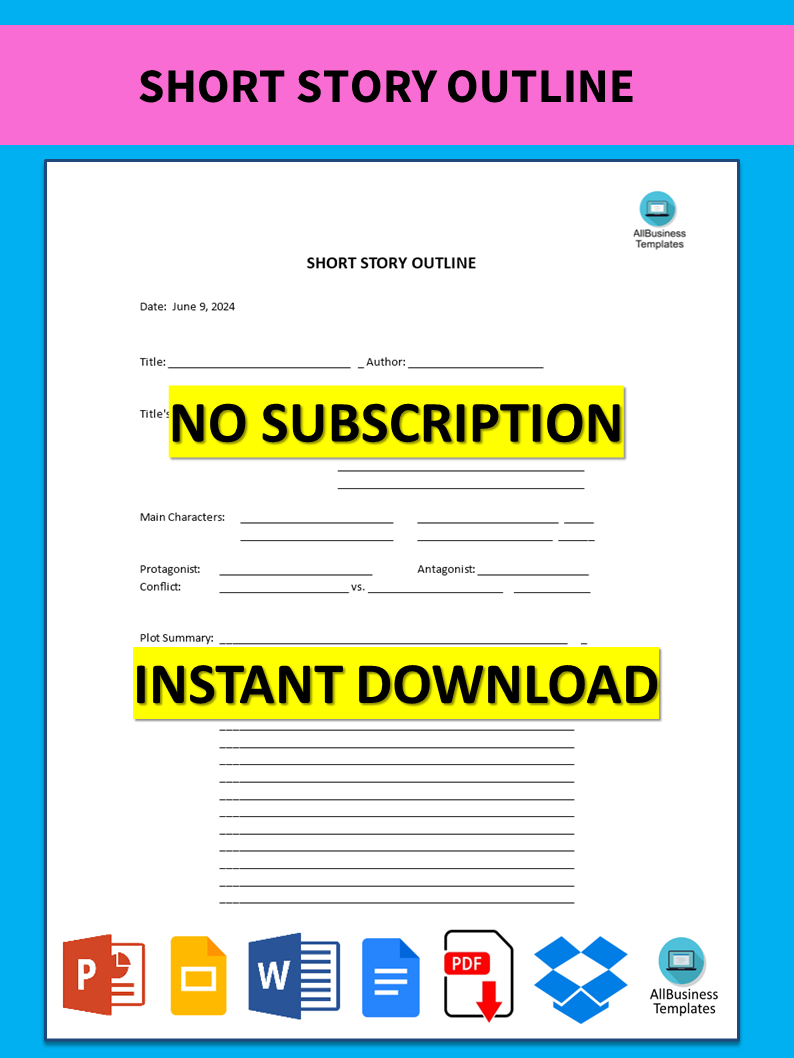Short Story Outline

I-Save, punan ang mga blanko, i-printa, Tapos na!
How to write a Short Story outline? Do you need a template for an outline of a short story? This sample outline template which can help you create a well-structured story.
Mga magagamit na premium na format ng file:
.docx- Itong dokumento ay sertipikado ng isang Propesyonal
- 100% pwedeng i-customize
Life Buhay Plot Ang plot Story Narrative Roman Novel film cast deal memo template deal memo template music story outline sample free short story outlines romance short story outline outline story writing examples short story outline worksheet short story outline example how to right a short story how to write a short story short story composition short story form short story background complex short stories outlining your novel map dramatic structure narration comic template template ng comic comic strip template template ng komiks strip structure of a comic short comic template maikling komiks template comic template maker gumagawa ng comic template 3 panel comic template 3 panel ng comic template 4 panel comic template comic strip maker for students gumagawa ng komiks strip para sa mga mag-aaral 8 panel comic template 8 panel ng comic template blank comic book for kids blangkong comic book para sa mga bata blank comic book blangkong komiks comic sketch book awesome comic book kahanga-hangang comic book comic book blank blangko ang komiks making comics Comic Book Template Template ng Comic Book understan comics the invisible art comic book design disenyo ng komiks how to draw comics maker comics drawing film director deal memo template sag actor deal memo deal memo example sag actor deal memo template deal memo film template talent deal memo template deal memo template google docs
How to write a Short Story outline? Do you need a template for an outline of a short story? This template can help you create a well-structured story with a clear beginning, middle, and end. It can also serve as a useful tool to help you brainstorm ideas and plan your writing.
When you are writing a short story, it's a good strategy to start planning its outline. Although a short story can be much looser in its structure and up for a lot of interpretation with loose ends, it's useful to follow a classic structure for guidance. Even if you're writing a more structureless story. This short story outline covers the most important topics that you are looking for and will help you to structure and communicate professionally with those involved.
A storyboard doesn't have to be an elaborate work of art. Here is how to make one:
- Download and modify a Story template: Draw a series of rectangles on a piece of paper, as if you were creating a comic strip, and also leave room for notes or lines of the script under each rectangle.
- Add the script: under each rectangle, write the line of script or dialogue that corresponds to that scene.
- Sketch out an interesting story: indicate movement with an arrow of basic figures. A bad drawing is better than no drawing! Alternatively, you may use existing images and paste them into the story.
- title's meaning
- main characters
- protagonist
- antagonist
- conflict
- intensify conflict
- plot summary
Finally, don't be too cautious about your story
- Take some chances.
- Ok to draw quickly and sloppily in the beginning, especially if you feel inspired and need to get your ideas down on paper.
- Go back and forth, and work on your storyboards.
- Have fun with your storyboards, they're the perfect tool for letting your imagination work.
- Here are a few more storyboarding tips:
- Use rectangles that are the same aspect ratio as the video, 16:9.
- Number each rectangle for easy reference in discussions.
- Bone up on the standard shot types used in the video before you start.
- Think in 3D. Make subjects/objects in the background smaller, so they appear further away.
- Cut up and recombine your storyboards to play with sequencing and narrative.
- Use the finished storyboard to create a master shot list. This way nothing will get overlooked during production.
- Keep the storyboard simple so it can be understood by anyone who views it,
- Be sure to share the finished product with everyone involved after its final cut!
Feel free to download this intuitive template which is available in several kinds of formats, or try any other of our basic or advanced templates, forms, or documents. Don't reinvent the wheel every time you start something new...
You can open the template in Google Docs or download it as a Word template to enhance efficiency! You'll succeed in delivering a well-structured and efficient story outline.
DISCLAIMER
Wala sa 'site' na ito ang dapat ituring na legal na payo at walang abogado-kliyenteng relasyon na itinatag.
Mag-iwan ng tugon. Kung mayroon kang anumang mga katanungan o mga komento, maaari mong ilagay ang mga ito sa ibaba.
